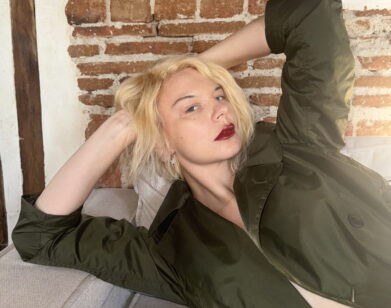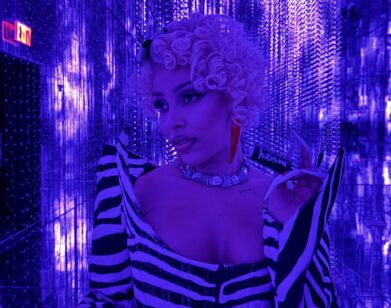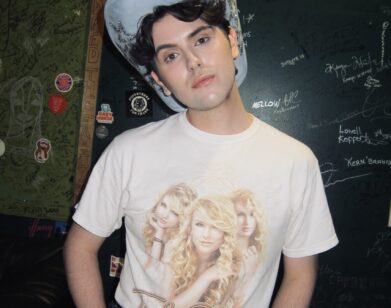The London Dubstep Scene
The latest music craze pulsing through London’s underground clubs is so loud that it can’t stay hidden much longer. Dubstep is less a party and more a sonic insurrection.
Anyone who likes to experience music at mind-alteringly loud volumes should attend a dubstep night immediately. The latest sound to infect the London underground is a combination of skittering beats, ass-quaking bass lines, and eerie atmospherics that can’t be fully appreciated on headphones. You can only get the full picture in person, when the bass is so enormous it actually makes your clothes flap. Dubstep, unlike most dance-music crazes, has taken root as a serious genre—almost a British equivalent of hip-hop, attracting fans like Massive Attack and Raf Simons—and has journalists and bloggers hailing it as the most important development in British music since jungle, a decade ago.
In London, where dubstep originated, there are two regular nights dedicated to the noise: DMZ, which takes place every two months at the Brixton club Mass, and the slightly less purist FWD (Forward) at Plastic People in Shoreditch. Both clubs speak volumes about dubstep’s music-first aesthetics: Each space is a pitch-black, dirty room with subwoofers the size of small bungalows emitting bass lines of awesome sonic force. And its fans aren’t too concerned about fashion or side conversation. “When the DMZ sound came in, it brought in very humble, dressed-down weed heads,” says FWD’s promoter Sarah “Soulja” Lockhart. “The club had an amazing vibe, but when I’d bring my girlfriends, they were like, ‘Who are these people?’ They wanted to drink champagne and be glamorous.” With beats that are half the speed of jungle and a sound that is often minimal, figuring out how to dance to dubstep can be tricky at first. Most people skank, rave, or just nod their heads. In this laid-back scene—which encompasses everyone from 18-year-old grime kids to first-generation techno fans—all three reactions are acceptable.
Dubstep has altered the DNA of underground dance music in the U.K. capital, and its sound is now rumbling around the world. Some fans, like the scene’s greatest champion in the outside world, BBC Radio 1 broadcaster Mary Anne Hobbs, discovered its brilliance like an epiphany: She first went to DMZ in 2005 after being knocked sideways by the first dubstep record she heard, War Dub by DJ Pinc & P Dutty. To others, like Lockhart, who is manager of the record label Tempa and head of the radio station Rinse FM, and whose former business partner Neil Jolliffe actually first named the music dubstep in a press release back in 2002, the genre is just the latest manifestation of a London-based dance scene whose illustrious lineage stretches all the way back to funk and reggae.
It’s generally accepted, however, that dubstep grew out of U.K. garage—the skippy pop soul that went aboveground and then died from overexposure in 2000. Like hip-hop, dubstep’s sound is defined by a small coterie of innovative, multimasking musicians who make records, release them on their own labels, and play them while out deejaying in clubs. The main players include artists like Mala and Coki (known together as Digital Mystikz), Benga and Skream, Loefah and DJ Hatcha, all of whom used to hang out in the Big Apple record shop in the South London borough of Croydon in the early 2000s. Their signature sounds are immediately recognizable to those in the know: Benga’s warped soul, Caspa’s wobbling bass lines, and the trippy techno influences in Skream’s jams. A lot of dubstep has a melancholy quality that has made it appealing to filmmakers (it saturated the soundtrack to the 2006 film Children of Men). “It’s dark but not aggressive,” says Mala of his own style, which he calls chamber music. “It expresses the struggle of growing up in London with no money.”
The radical nature of the sound, together with the fact that it’s mainly instrumental, means that dubstep will never be mainstream. But one artist has broken through: Burial, whose album came within a whisker of winning the high-profile Mercury Prize for best British album last year. But even if Burial is the most famous constituent, the dubstep scene is populated with fascinating characters, like sparky 22-year-old Benga Adejumo, who we discover in bed at 8:30 p.m., watching TV in his vast, chilly suburban house; Goodman, an academic by day who’s just finished a book on sonic warfare; and 26-year-old Gary McCann, known as Caspa, who puts in 22-hour days as a musician, DJ, and entrepreneur, with three record labels to his name. Yet dubstep has an exclusivity as well. Most of the artists are disdainful of soulless MP3 culture and prefer to play dubplates—one-off acetate vinyl records pressed exclusively for them, which last for around 150 spins. “I even feel that tapes are more precious, because of the very fact that in order to make a tape you have to sit there for the 90 minutes,” says Mala, who cofounded DMZ. “I run record labels, not CD or MP3 labels.”
Dubstep is bound to reverberate through 2009—many of the DJs are booked up around the world for most of this year—yet there’s anxiety about the way it’s progressing. While Hobbs describes the evolution of dubstep as “like the flowers of some exotic bloom in the Amazon rain forest which open a different petal every day,” to Goodman, the music has polarized into two none-too-interesting schools: “Jump-up stuff, with bass lines that sound like a duck farting, and stuff that would like to be techno.” Criticizing some fans who act like “genre police” on message boards like dubstepforum.com, he adds, “I’m no longer interested in being tribalistic about a certain sound.”
Yet the creativity inherent in dubstep’s top producers is driving the scene relentlessly forward. “I hope we release albums that will make people go, ‘Whoa, let’s just go all creative and mad,’ ” says Benga, whose second album is due out in March. Goodman’s music, meanwhile, is becoming influenced by a new, lighter genre called funky—a sound a good deal more imaginative than its name. “If you want any serious recognition as a producer, you have to come with a completely unique sound,” says Hobbs. Yet the scene is up to the challenge. “The people who are part of dubstep can’t help but create,” says Lockhart. “They’ll keep coming up with other things.” And that’s the bottom line.







